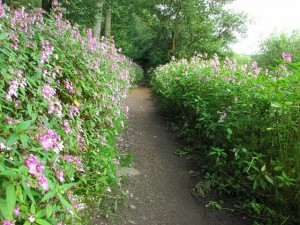Jättebalsamin
Jättebalsamin
Latinskt namn: Impatiens glandulifera
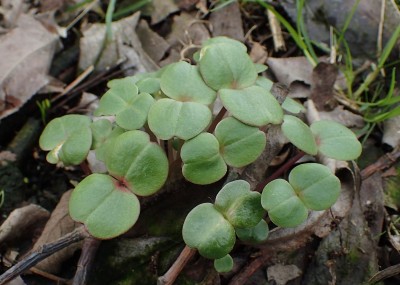
Foto: Krzysztof Ziarnek, Kenraiz, commons.wikimedia.org CC BY-SA 4.0
Overview:
It appeared in Finland in the late 1800s as a garden plant – as an ornamental plant and it was easy to care for. Then it began to spread actively and now it has gone beyond gardens, taking over the territory and destroys unique local species. This plant is very invasive, especially in coastal areas and wetlands. Its growth rate is spectacular for an annual plant, it could reach 3 meters in height. It has a negative impact, dominates and actively invades riverbanks, contributing to erosion, and threatening the quality of water bodies and fish populations. The plant spreads at an incredible rate due to more than 4000 seeds per plant. The seeds can survive for up to two years, and the seed seedlings can move due to explosive energy when touched or disturbed at up to 7 meters. Balsam takes the attention of pollinating insects, and they ignore the local plant species. This is since it blooms from June to September and produces strong-smelling nectar in large quantities that attract pollinators.
Habitat:
Himalayan balsam prefers nutrient-rich, moist natural areas such as lake and riverbanks, wetlands, and coastal areas typical of Southern Finland. It is tolerant of partial shade, but sensitive to frost.
Influence:
Ecology: Due to its ability to compete with native species in coastal areas, infection with Himalayan balsam reduces plant diversity in these areas and can damage ecosystems. Himalayan balsam has extremely sweet nectar that can attract pollinators and reduce the pollination of native plants.
Economy: The shallow root system and annual nature of the plant expose the land under fields with a monoculture of Himalayan balsam to erosion during the winter period. Soil that is not associated with perennial vegetation is washed away by rainwater into ditches, rivers, and lakes and may pose a threat to trout or fry spawning.
Identification:
Seeds: The seed pods are 2 to 3 centimetres long and explode if disturbed. Each plant can produce up to 4000 seeds.
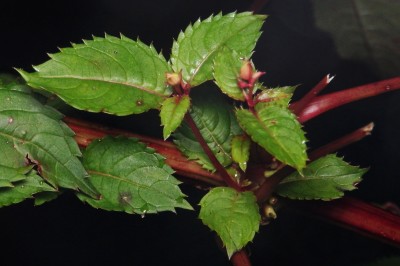
Foto: Ryan Hodnett, commons.wikimedia.org CC BY-SA 4.0
Leaves: The leaves are 5 to 20 centimetres long, lance-shaped, and grow oppositely or in threes. The edges of the leaves are sharply serrated.
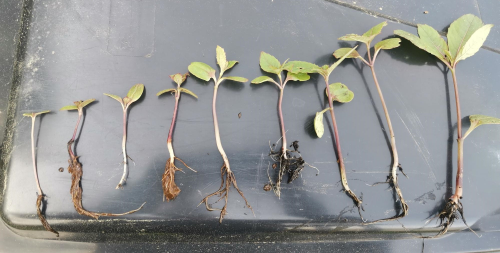
Foto: Dmitrii Plekhanov
Stems: hexagonal stems with a purple or red hue that can grow from 1 to 3 meters in height. The stems are smooth, lint-free, hollow, and break easily.
Flowers: The flowers are pink sometimes with white flecks or light pink with a hood and grow in clusters of 5 to 10 flowers per stem. The plant has a long flowering period, approximately from June to October.
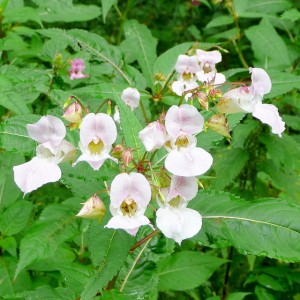
Foto: Jonathan Billinger, commons.wikimedia.org CC BY-SA 2.0
Prevention:
Himalayan balsam was introduced to Finland as an ornamental plant. But since then, the plant has escaped into nature. Do not buy or grow Himalayan balsam. When removing this plant, make sure that proper removal measures are taken, another plant is planted in the vacant space, monitor this site and arrange for subsequent care. Do not remove the plant during the ripening period of the beans.
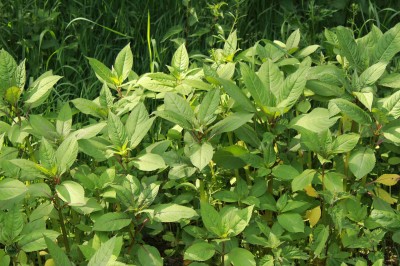
Foto: Luca van der Leeden, commons.wikimedia.org CC-BY-SA-4.0
Manage:
Mechanical removal by repeated mowing is effective for large plantings, but plants can recover if the lower part and roots are left intact. Ploughing or mowing at ground level helps to stop regeneration. However, access to the growing areas can be difficult, and hard-to-reach Himalayan balsam plantings can quickly recover again. It is necessary to monitor the cleared territories. Small areas can be controlled by removing the plants with small hands, as the root of the Himalayan balsam is very shallow. It should be borne in mind that the removal is carried out only if there are no visible seeds since their shedding leads to further contamination of the soil. In the case of removing the balsam in the presence of seeds (usually in late May-June), put a bag on top of the plant to avoid further spread. Since the seeds are stable and are stored for about 2 years, harvesting can be completed in two years, provided that all plants are properly disposed of and removed. After removal, the plants are placed in a black garbage bag and placed on an impermeable surface for 1 week. This will destroy all viable materials before disposal.
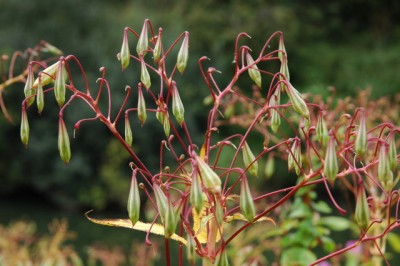
Foto: Philip Halling, commons.wikimedia.org CC BY-SA 2.0
References:
https://abinvasives.ca/fact-sheet/balsam-himalayan/ Impatiens glandulifera.
Wikipedia: The Free Encyclopedia. 2013. www.wikipedia.org
https://invasivespeciescentre.ca/invasive-species/meet-the-species/invasive-plants/himalayan-balsam/

